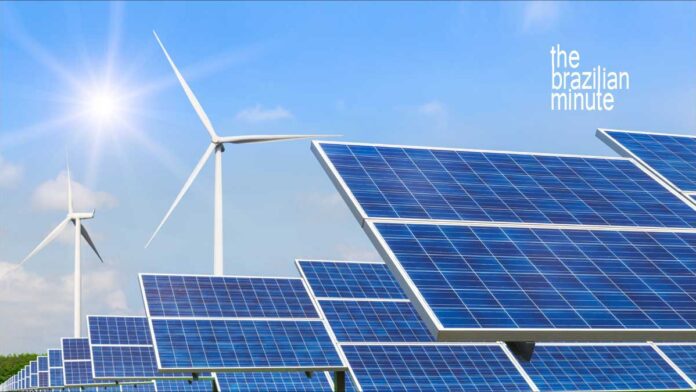Blessed with sea, sun, and wind, Brazil has become a global leader in renewable energy.
Brazil’s leading role with renewable energy may come as a surprise to some but its policies are highly regarded concerning the world’s most pressing energy needs.
.
This series was presented by the Consulate-General of Brazil in Chicago and the Brazilian Foreign Ministry’s Cultural Department.
In celebration of Brazil’s Bicentennial year, 1822 – 2022
This week’s Brazilian Minute: Brazil’s Leading Role With Renewable Energy
Catch up with other Brazilian Minute episodes you may have missed!
Script from Audio:
When we think of ‘energy’, words like ‘renewable’ and ‘sustainable’ are on everyone’s mind. Let’s add one more word. ‘Brazil’!
A world leader in Renewable Energy for more than 50 years, Brazil’s energy policies are highly regarded concerning the world’s most urgent energy challenges, including solar and wind power development.
Brazil leads all of Latin America in Energy production, more than the combined power produced by all other South American nations.
Renewable energy creates about 45% of Brazil’s energy demand. Brazil’s energy profile is one of the world’s least carbon-intensive.
Sugarcane is Brazil’s leading source for Renewable Energy. Hydroelectric power provides 65% of Brazil’s electricity.
Here’s a fun fact: The Itaipu Dam is the second-largest power station on Earth, and one of the Seven Engineering Wonders of the Modern World!
Read and listen to new weekly episodes of The Brazilian Minute.

More on: Brazil’s Leading Role With Renewable Energy
Overview On: Brazil’s Leading Role With Renewable Energy
The internationally-respected International Energy Agency (IEA) reports that Brazil’s energy policies compare favorably with other countries around the world. This is especially true when our most urgent energy challenges are considered.
Brazil is one of the least carbon-intensive countries in the world. Its energy sector comfortably serves the electrical needs of the nation. Currently, an array of renewable energy sources meet approximately 45% of energy demand.
Brazil’s role as a key player in renewable energy began in the 1970s. That’s when it started the construction of large hydroelectric plants throughout the country. Brazil’s abundant sugarcane crops have helped it to become a pioneer in the production of ethanol.
Fun Fact about Brazil’s Renewable Energy
Consequently, Brazil’s energy matrix is much more renewable than the rest of the world. 45% of Brazil’s energy matrix is renewable.
The Brazilian Energy Planning Agency (EPE) targets renewable sources as an ongoing priority. The IEA’s Global Energy Review from 2020 reports that Brazil is currently targeting 48% of its energy matrix.
Worldwide the percentage share of renewable energy makes up 28% of the world’s energy profile. Current events in Europe illustrate how important sustainable and renewable energy independence is for any country.
Breaking Down Brazil’s Renewable Energy Resources
When it comes to Brazil’s renewable energy resources, Sugarcane leads the way. Energy from sugarcane and its byproducts provides 39.1% of Brazil’s renewable energy profile.
Hydroelectric power plants run a close second. They provide 27.6%, while vegetal coal and firewood supply 18.8%. Emerging renewables including solar, wind, and biomass contribute 14.5% of Brazil’s renewable energy use.
Ultimately, Brazil’s electricity profile is considered to be one of the cleanest in the world.
Brazil’s commitment to its role as a world leader in renewable energy projects continues. Advanced application of wind power, solar power, and expanded hydropower capacity is ongoing.
Let’s see how Brazil does it.
Hydroelectric Power
Fully 65% of Brazil’s electricity comes from hydroelectric power stations. Brazil has the third-highest projected expansion for hydroelectricity, following Russia and China.
The Itaipu Dam is the world’s second-largest hydroelectric power station in the world. The American Society of Civil Engineers named Itaipu one of the seven engineering wonders of the Modern World.
Here’s a fun fact: In 1989, avant-garde composer Philip Glass created a symphonic cantata titled Itaipu as a musical tribute. He presented it with the Atlanta Symphony Orchestra.
The US Trade Department has determined that Brazil is the largest electricity market in Latin America.
Here’s an impressive stat. Brazil generates and distributes electricity to more than 85 million consumers. Its electrical output serves residential, commercial, and industrial needs.
Brazil’s electrical service is greater than all the power generated by the rest of South America, combined. Looking to the future, Brazil anticipates that investment in its energy sector will grow to $94 billion by 2029.
Wind Power
Brazil’s advancements in wind power is has accelerated in recent years. Currently, Brazilian winds can generate up to 500 gigawatts of electrical energy.
According to the International Renewable Agency (IRENA), Brazil is the fastest-growing wind power market in South America. Globally, Brazil is ranked 7th by the Global Wind Energy Council, and in 2016, it was considered the 5th best wind market in the world.
What part of Brazil is the largest producer of wind energy? Look no further than Rio Grande do Norte. The Hustle reports, that “according to Bloomberg Tech, breezes from the Northeast of Brazil are “so perfect” for these windmills that Brazil is capable of spinning more wind energy than any other region on the planet.”
Fun fact: Brazil debuted its first wind energy turbine in 1992. It was installed in the Fernando de Noronha Archipelago, 340 miles off the coast of Pernambuco.
Solar Power
For decades, we’ve known that the Brazilian sun powers the nightlife in Rio de Janeiro. But because Brazil is one of the world’s sunniest countries, it also has one of the highest rates of solar incidence, anywhere.
Brazil’s sheer size helps it to be a leading nation in the conversion of sunlight into usable energy, too.
Looking for Brazil’s largest solar facilities? They are located in Ituverava and Nova Olinda. They are hundreds of miles inland from Belo Horizonte and Recife, respectively.
Biofuels
Brazil is the second-largest producer of ethanol in the world and is the largest exporter of ethanol. Brazil’s biofuel industry dates to 1975 and the ProAlcool program.
Brazil’s National Energy Plan 2030 (PNE) established annual production goals of 66 billion liters for bioethanol and 18.5 billion liters for biodiesel. The plan’s target date is 2030. It is intended to provide biofuel security for domestic use while meeting the challenges of international competitiveness.
All Brazilian gasoline contains ethanol. When it comes to renewable energy for cars, trucks, and motorbikes in Brazil, ethanol is the answer.
Music, Travel, Friends and Fun! 2022 marks Connect Brazil’s 25th year.
Brazil’s Leading Role With Renewable Energy
Did you enjoy ’Brazil’s Leading Role With Renewable Energy’? If you did, why not join us at Connect Brazil?
Sign up for our emails on Brazilian music, travel, friends, and fun. Listen to our ‘always live’ streaming station and 15 streaming music channels, always free. Visit us on Facebook, and Twitter, and browse our Lifestyle Directory for Brazilian events coast to coast.









